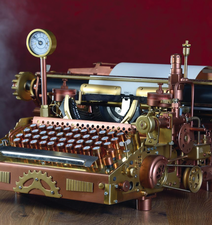Reinventing the keyboard
Open Hardware – Keyboardio

© Lead Image © 3355m, 123RF.com
The Keyboardio Model 01 is a highly-customizable open hardware keyboard.
For a while, the Keyboardio [1] Model 01 seemed destined to never ship. Although its 2015 crowdfunding campaign raised over five times its goal of $120,000, production was repeatedly thwarted by problems with manufacturers and quality control – all of which is recorded in painstaking detail on the company blog [2], and which should become required reading for any would-be hardware vendor. Yet despite everything, in November 2017, the Model 01 keyboard finally began shipping. Although shipping is still seriously backlogged, the Model 01 (Figure 1) turns out to be worth waiting for, both as a high-end ergonomic keyboard and as one of the most customizable pieces of open hardware ever produced.

The Model 01 is a mechanical keyboard built with Matias keyswitches [3] that are not only longer-lasting and easier to repair than the usual cheap membrane keyboards, but require less pressure to activate than standard keyswitches. The minimalist keyboard of 64 keys ships with three layers – that is, key bindings that can be activated while pressing a command key, just as the default lowercase keys produce uppercase letters when the Shift key is pressed. With the Model 01, pressing the Num key activates the number pad and arrow keys, while pressing the Fn key activates the 12 function keys, Delete, and square and curly brackets. The default layers are illustrated on a laminated sheet that ships with the Model 01.
[...]
Buy this article as PDF
(incl. VAT)
Buy Linux Magazine
Subscribe to our Linux Newsletters
Find Linux and Open Source Jobs
Subscribe to our ADMIN Newsletters
Support Our Work
Linux Magazine content is made possible with support from readers like you. Please consider contributing when you’ve found an article to be beneficial.

News
-
Parrot OS Switches to KDE Plasma Desktop
Yet another distro is making the move to the KDE Plasma desktop.
-
TUXEDO Announces Gemini 17
TUXEDO Computers has released the fourth generation of its Gemini laptop with plenty of updates.
-
Two New Distros Adopt Enlightenment
MX Moksha and AV Linux 25 join ranks with Bodhi Linux and embrace the Enlightenment desktop.
-
Solus Linux 4.8 Removes Python 2
Solus Linux 4.8 has been released with the latest Linux kernel, updated desktops, and a key removal.
-
Zorin OS 18 Hits over a Million Downloads
If you doubt Linux isn't gaining popularity, you only have to look at Zorin OS's download numbers.
-
TUXEDO Computers Scraps Snapdragon X1E-Based Laptop
Due to issues with a Snapdragon CPU, TUXEDO Computers has cancelled its plans to release a laptop based on this elite hardware.
-
Debian Unleashes Debian Libre Live
Debian Libre Live keeps your machine free of proprietary software.
-
Valve Announces Pending Release of Steam Machine
Shout it to the heavens: Steam Machine, powered by Linux, is set to arrive in 2026.
-
Happy Birthday, ADMIN Magazine!
ADMIN is celebrating its 15th anniversary with issue #90.
-
Another Linux Malware Discovered
Russian hackers use Hyper-V to hide malware within Linux virtual machines.

